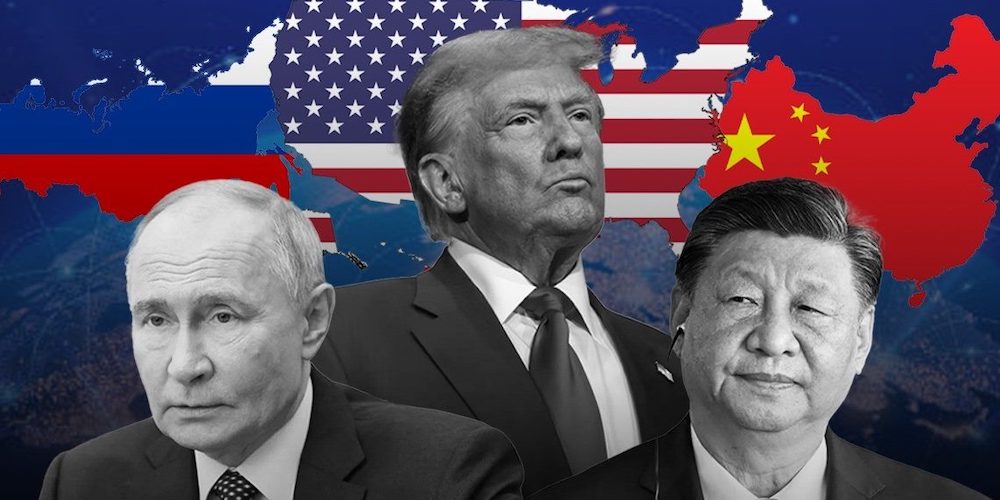A New World Order?

Anew world order is taking shape with the US and China as the two poles in a supposedly multipolar world. Everyone else is desperately trying to save skin, mostly at others’ expense
Like others, India must also brace for the new order. The US and the Soviet Union, superpowers of the last century, were located far away. Today, China is next door and has a festering border dispute. It has surged at a pace India cannot easily match.
Moscow, which afforded a high measure of diplomatic comfort and weapons, now Number 3, perhaps, remains a reliable friend, but is open to doing business with others – just as Delhi does.
India, supposedly the US’s strategic partner, is perceived as one to the world outside, despite its frequent resort to ‘autonomy’. But the US can tilt towards Pakistan, as Mr Trump is currently doing. Keeping India on its toes on trade matters, it is clasping it in a tight security embrace, as evident from the latest batch of pacts that Defence Minister Rajnath Singh signed.
These are truly transactional times: you are either with me or against me. No halfway. India may not be isolated, but it is surely surrounded by unreliable friends, a perennial foe (Pakistan) and a friend-turned-foe (Bangladesh). It has sought to play its difficult cards with great caution. Its leadership oscillates between protesting being singled out for punishment abroad and orchestrating a nationalist language at home, keeping the public anger under control.
In a sense, the new world order crystallised at Busan in South Korea, where Trump met Xi Jinping. They agreed on a cease-fire. The spectre of a World War 3 that Trump had warned earlier has receded.
But a ceasefire does not guarantee peace — not with the Ukraine conflict getting nowhere near an end and the one over Gaza remains iffy with Israel’s Netanyahu ready to violate it for half a reason.
Here, we are not talking of seven conflicts, including one between India and Pakistan, that Trump claims he has already resolved. He is ready for more, but on his terms, which are strictly give-and-take.
What can be India’s gains or losses from the Trump-Xi meeting? For all its global aspirations and calls for an end to conflicts, it is like a burnt toast desperately awaiting a little more butter than is applied.
It is in an unenviable situation. A trade deal with the US that should have come six months ago is only ‘imminent’ as of now. India has to read Trump’s signals, which come almost daily, but are full of contradictions.

A thaw between the US and China after the Trump-Xi meeting should have been helpful. But only consolation prizes have come, like China allowing export of rare earth material and the US allowing an extremely short, six-month waiver on the Chabahar port, where India has invested much in Iran.
As for the punishment for purchasing Russian oil, Trump did not even discuss the issue with China, which buys more of that commodity than India does. India switching to more American oil — at a price we will not be told — may have appeased Mr Trump, but not enough.
Yet, give the Devil his due, if not the Nobel, in Southeast Asia. He had earlier wrecked the decades-long arrangement that helped the emergence of “Asian tigers” and pushed them closer to China. Last month, he struck lucrative deals with Malaysia, Thailand, Cambodia and South Korea. China would be wary of this ‘invasion’ into what it thinks is its regional backyard. Trump also endeared himself to Japan on his very first meeting with its first woman PM.
Yet, distrust persists about Trump’s mercurial ways, experts aver at the East Asia Forum. Essentially, a businessman who believes in everything he does as a transaction- give and take. The world has come to know him as the great disruptor who uses tariffs and trade as a weapon. But his diplomacy in Southeast Asia may win him admirers on the diplomatic front as well.
Not to be outdone, after meeting Trump, Xi addressed the APEC summit and guaranteed “shared trade benefits” to all in the region. Time will tell which way the ‘tigers’ and others in the region may look.
Trump has moved on to other tasks. On the Atlantic, although he has failed to bring the promised peace to the Ukraine peace deal, he has cajoled and coaxed the European allies into spending more on defence, basically to defend themselves from Putin.
The fast-paced diplomacy shows that much water has flowed down the Yangtse, the Moscow, the Potomac — and the Jamuna — since the Shanghai Cooperation Organisation (SCO) meeting in Tianjin. Modi’s presence there had rattled the US and perhaps delayed the trade deal further. The new date is mid-November, India’s soothsayers and supporters say.
On the negative side, normalisation of US-China ties isn’t good news for middle powers, including India, which gained a tactical advantage by playing the big powers against one another. They had demonstrated their commitment to regional stability by simply being there.
It is a US-China ceasefire, for now. But the competition will surely not end. Come to think of it, it is okay and merciful, and is better than fighting. One only hopes that when the Big 2 ceasefire, their proxies will also learn.


